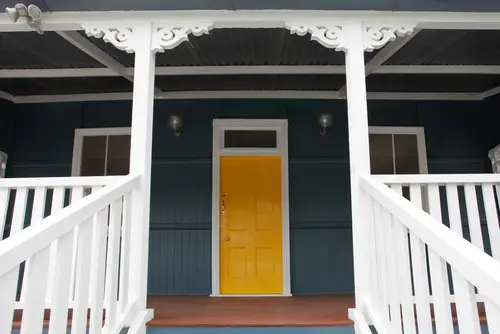|
Mr. Handyman® experts explain that repainting is more than cosmetic—it protects your home from weather, wear, and fading. Knowing when to repaint helps prevent costly repairs and keeps your home looking its best.
|
A fresh coat of paint can completely change how your home looks—and how it feels to live in it. In this guide, we’ll walk you through five clear signs it’s time to repaint your home and how to get the process started. Whether you’re updating a single room or refreshing your exterior, professional house painting services make the process simple.
- 5 Signs It’s Time to Repaint Your Home
- What to Do After You Notice Paint Damage (5 Steps to Refresh with Confidence)
- The Benefits of Painting Now (and Risks of Waiting)
- How Often Should You Repaint Your Home?
- Ready to Refresh Your Home with Residential Painting Services?
- FAQs About Residential Painting Services
5 Signs It’s Time to Repaint Your Home
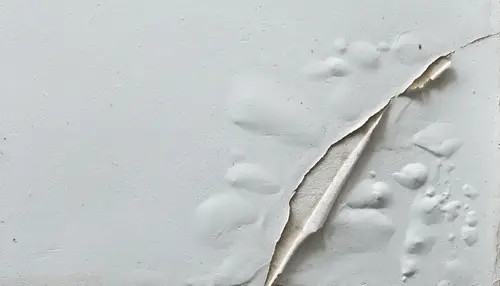
Repainting your home means applying a fresh layer of protection and color to surfaces that have started to fade, crack, or wear out. Here’s what to look for before minor paint issues become costly repairs:
1. Peeling, cracking, or bubbling paint
Paint starts to peel or bubble when it loses its bond with the surface beneath. Moisture or age can cause this separation, leaving drywall, wood, or siding exposed.
Why it matters: Peeling paint lets moisture reach the surface, which can cause rot, warping, or mold growth over time.
2. Fading or discoloration
Years of sunlight and temperature changes gradually dull your home’s color. If walls or siding look washed out—or you can see clear shade differences across surfaces—it’s a sign that your paint’s UV protection is wearing off.
Why it matters: Faded paint exposes your home to cracking and premature aging, both inside and out.
3. Stains or marks that won’t clean
When scrubbing doesn’t lift stains, grease, or scuff marks, your paint’s finish has worn thin. Kitchens, hallways, and kids’ rooms tend to show these signs first.
Why it matters: Once paint loses its finish, it stops protecting surfaces from moisture, spills, and daily wear.
4. Chalking or powdery residue
Run your hand along an exterior wall. If you notice a fine, powdery dust, that’s chalking. It’s what happens when paint binders break down in the sun.
Why it matters: Chalking means your paint film is deteriorating and no longer sealing the surface beneath, leaving it vulnerable to UV and rain damage.
5. Visible wear in high-traffic or exposed areas
Trim, doors, railings, and siding edges take the brunt of daily activity and weather. Chips and uneven color are early warnings that your home’s protection is wearing thin.
Why it matters: Repainting these areas early keeps your home looking fresh and prevents more extensive (and expensive) repairs later.
|
Pro Tip: Before repainting, check out some ideas to improve or renovate your home’s exterior for simple ways to make your home shine even brighter once your new paint job is complete. |
If you’ve spotted any of these five signs, your home’s paint is past its prime. Waiting can lead to more than just dull color; calling a residential painter early helps protect your home’s structure, save you from costly repairs, and give your home an instant refresh.
What to Do After You Notice Paint Damage (5 Steps to Refresh with Confidence)
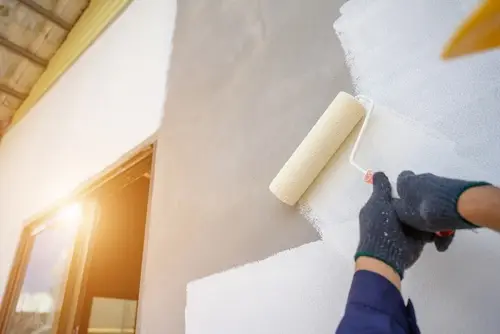
Paint damage—like peeling, fading, or bubbling—is your home’s way of saying it’s ready for a little attention. Once you’ve spotted those signs, a few smart next steps can make the repainting process easy, efficient, and long-lasting.
1. Start with a close look
Walk around your home, both inside and out. Look for surfaces where paint is peeling, cracked, or chalky to the touch. Pay special attention to window trim, baseboards, and siding edges—these areas are most exposed to moisture. If you notice wood rot, bubbling, or soft spots, those sections should be repaired before repainting.
2. Decide where to begin
If you see damage in several places, start with the area showing the most wear. For many homeowners, that means exterior surfaces first—especially if they face direct sun or heavy rain. Once the outside is protected, interior spaces can follow without pressure or overlap.
3. Pick the right paint for your space
Quality paint lasts longer and protects better than bargain options. Choose moisture-resistant paints for kitchens, bathrooms, and exteriors, and washable finishes for high-traffic indoor areas. In sunnier regions, look for UV-resistant paint to prevent fading.
4. Entrust the prep and painting to a pro
Hiring a professional residential painter means you get precision without the mess. Pros handle every detail—from sanding and priming to edging and cleanup—so you’re left with smooth, even results that stand the test of time. Plus, an expert can identify hidden issues like water intrusion or rot before they become bigger problems.
5. Protect your results
After your new paint is complete, maintenance is key. Keep gutters clear, trim back shrubs touching the siding, and gently clean walls a few times a year to extend your paint’s life. Small touch-ups now prevent major repainting costs later.
The Benefits of Painting Now (and Risks of Waiting)
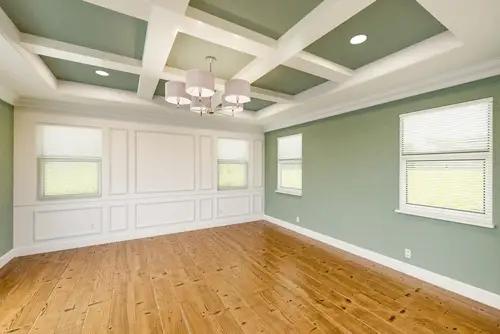
Timing matters more than most homeowners realize. Repainting before paint starts to fail saves money, prevents deeper structural damage, and keeps your home looking well-maintained. Waiting too long can turn a simple paint refresh into a full repair job.
Why acting now pays off
A fresh coat of paint does more than improve appearance—it seals out moisture, sunlight, and pests. Acting early means fewer repairs, lower labor costs, and better long-term protection. A timely repaint also boosts curb appeal and resale value, showing pride of ownership that buyers and neighbors notice right away.
What happens when you wait too long
Once paint starts peeling or cracking, the surface beneath becomes vulnerable. Moisture seeps in, wood or siding begins to warp, and repair prep, such as sanding, scraping, and priming, multiplies—all of which adds to the final cost. Sun and weather only speed up the damage further.
Repainting before your paint fails will help keep your home protected, beautiful, and easier to maintain. It’s one of the simplest upgrades that delivers lasting results and everyday pride in your space.
How Often Should You Repaint Your Home?
The right repainting schedule depends on your materials, location, and daily wear. Repainting too soon wastes effort, but waiting too long can invite damage that’s expensive to fix. It’s a tricky balance, but we’re here to help you master it.
Here’s a quick guide to how long paint typically lasts on different surfaces:
| Surface / Area | Recommended frequency | Why it matters |
|---|---|---|
| Exterior wood or siding | Every 5–7 years | Exposed to weather and UV rays; repainting prevents warping, cracking, and rot. |
| Brick or stucco | Every 7–10 years | Porous surfaces absorb moisture; sealing and repainting preserve structure and color. |
| Interior walls | Every 3–5 years | Daily activity, fingerprints, and sunlight fade paint faster—especially in kitchens and hallways. |
| Trim and doors | Every 2–4 years | High-traffic areas chip and scuff easily; frequent repainting keeps edges crisp. |
| Ceilings | Every 10 years (or as needed) | Minimal exposure but may yellow over time from humidity or smoke. |
If you live in a coastal or humid region, more frequent repainting may be needed. Salt air, heat, and moisture can all shorten your paint’s lifespan. Investing in high-quality paint and professional prep helps extend the finish.
Ready to Refresh Your Home with Residential Painting Services?
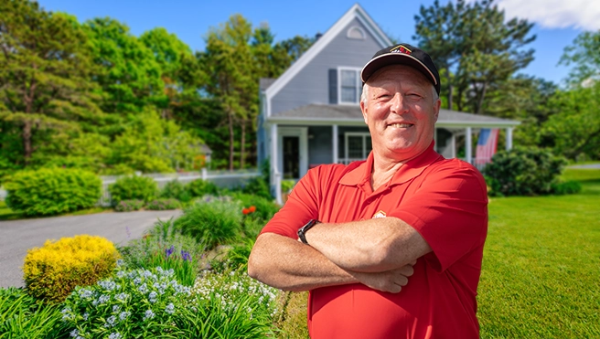
A new coat of paint isn’t just a finishing touch—it’s a fresh start for your home. From the moment you walk through the door, paint sets the tone and reflects your pride in your space.
Whether you’re refreshing one room or reviving your home’s exterior, you deserve results that last—and professionals who treat your space with care. That’s exactly what you’ll get with residential painting.k services from Mr. Handyman.
Our team handles every detail: from careful prep, clean edges, and quality finishes to a spotless cleanup when we’re done. With trusted craftsmanship backed by the Neighborly Done Right Promise®, you can relax knowing your home will look great today and stay protected for years to come.
Transform your space. Protect your investment. Feel proud every time you pull into your driveway.
Schedule your painting service with your local Mr. Handyman team and bring new life to your home—done right the first time.
This article is intended for general informational purposes only and may not be applicable to every situation. You are responsible for determining the proper course of action for your home and property. Mr. Handyman is not responsible for any damages that occur as a result of this blog content or your actions. For the most accurate guidance, contact your local Mr. Handyman location for a comprehensive, on-site assessment.
FAQs About Residential Painting Services
For over 25 years, Mr. Handyman professionals have been helping homeowners and businesses repair, maintain, and enhance their space. We are a one-stop solution for everything on your to-do list. This includes answering your questions about home repairs, maintenance, and improvements. Here are answers to some of your most frequently asked questions about house painting services.
What’s included in a residential painting estimate?
The price of a residential painting service depends on square footage, paint quality, and prep needs. Our painting estimates include:
- Labor costs: This covers the time and expertise of our professional painters.
- Paint materials: We use high-quality paints and primers specifically suited for the project and surfaces.
- Drop cloths and masking materials: We provide all the necessary materials to protect your home during the painting process.
- Cleanup: Our painters take pride in leaving your space clean and tidy upon completion.
Homes with damaged or textured surfaces may take more time and material. For a deeper breakdown of what influences interior pricing, check out our national blog on how much it costs to paint the interior of a house.
What type of paint lasts the longest?
Acrylic latex paint offers the best durability and weather resistance for most interior and exterior projects. It resists cracking, fading, and mildew while staying flexible in changing temperatures.
For high-traffic spaces like kitchens or bathrooms, a satin or semi-gloss finish holds up best to moisture and cleaning. Your local Mr. Handyman painting professional can help match the right finish to each room or surface type for maximum lifespan.
Can I paint over old paint, or does it need to be removed first?
You can repaint over existing paint if it’s clean, dry, and firmly attached.
If old paint is peeling, cracking, or chalky, those areas must be sanded, cleaned, and primed before applying a new coat. Professionals handle this prep to ensure smooth adhesion and a long-lasting finish.
If you suspect your home has lead-based paint, consult a Mr. Handyman professional for advice.
How long does a professional paint job last?
Interior paint typically lasts 5 to 7 years, while exterior paint lasts 5 to 10 years.
The lifespan depends on surface prep, paint quality, and weather exposure. Homes in sunny or humid climates may need repainting sooner. Routine maintenance, like wiping down walls and fixing small chips, helps extend your paint’s life significantly.
Is hiring a professional painter worth it?
Yes, professional painting delivers longer-lasting results and less stress than DIY painting. Pros have the tools and experience to prep, prime, and finish surfaces efficiently. That means cleaner lines, faster turnaround, and fewer touch-ups later.
With house painting services from Mr. Handyman, your project is done right the first time—backed by the Neighborly Done Right Promise® for lasting peace of mind.
What time of year is best to paint my home?
Spring and fall are ideal for exterior painting because temperatures are mild and humidity is lower, helping paint dry evenly.
Interior projects can happen any time of year if rooms are ventilated and humidity is controlled. Your local Mr. Handyman team can help schedule your project around local weather to ensure the best results.
